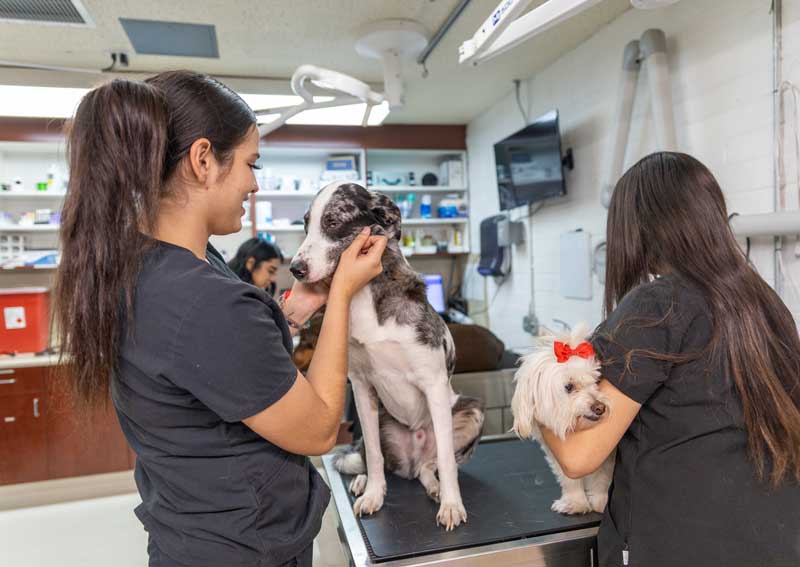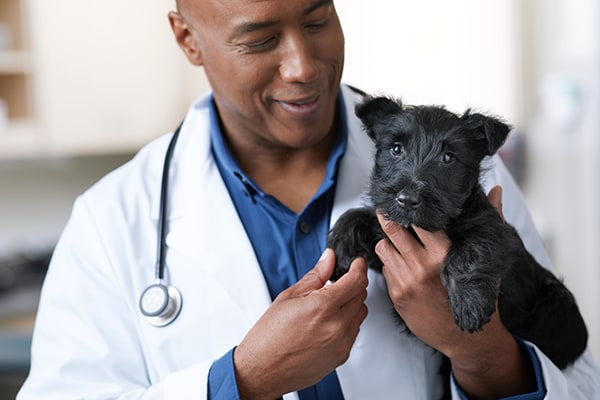Everything You Need to Know About tplo surgery: Benefits, Risks, and Recovery
Everything You Need to Know About tplo surgery: Benefits, Risks, and Recovery
Blog Article
Why Pet Rehabilitation Is Important: the Perks of Vet Providers for Your Family pet's Recovery
Animal rehabilitation is a crucial part of healing for pet dogs encountering injuries or disabilities. Veterinary solutions supply crucial assistance via tailored rehabilitation strategies that resolve specific needs. These plans usually include pain administration, physical treatment, and nutritional advice. Recognizing the various aspects of pet rehabilitation can brighten its significance in improving healing outcomes. What certain advantages do these services provide, and exactly how can they transform a family pet's healing trip?
Comprehending Pet Rehab
Pet recovery encompasses a variety of therapeutic techniques focused on restoring the health and capability of hurt or disabled pets. This field incorporates numerous methods, consisting of physical treatment, hydrotherapy, and job-related therapy, customized to meet the details demands of each pet. Rehabilitation experts evaluate a pet's condition, developing personalized treatment plans that may involve workouts to strengthen muscle mass, improve movement, and improve overall wellness. The procedure not only concentrates on physical healing yet also addresses psychological and behavioral aspects. Pets commonly experience anxiety and anxiety adhering to an injury, making psychological health and wellness factors to consider important in rehab. By developing an encouraging setting, specialists can assist pets regain their confidence and adapt to their new conditions. With routine sessions, animals can experience significant enhancements, eventually bring about a much better lifestyle. In general, understanding animal rehabilitation highlights its significance in promoting healing and boosting the bond between family pets and their owners.
The Function of Discomfort Administration in Recuperation
How important is efficient discomfort management in the healing of damaged pets? It plays an essential role in facilitating healing and boosting the total wellness of pets. Proper pain administration not just minimizes pain yet additionally advertises wheelchair, allowing animals to take part in recovery activities essential for recuperation. When discomfort is efficiently managed, animals often tend to respond positively to treatment, causing quicker recovery outcomes.Veterinarians use numerous methods to evaluate and resolve discomfort, consisting of drugs, acupuncture, and alternative therapies. By customizing pain management approaches to the private requirements of each animal, veterinarians can guarantee that pets continue to be calm and cooperative throughout their recovery trip. Additionally, lessening pain aids lower stress, which can hinder healing and lengthen recuperation times. To summarize, reliable discomfort administration is important for improving the recuperation procedure and improving the high quality of life for damaged animals.
Physical Treatment Methods for Pets
Many physical therapy methods are offered to help in the rehabilitation of pet dogs recouping from injuries or surgical treatments (canine tplo surgery). These methods can improve flexibility, soothe discomfort, and promote recovery. Restorative workouts, for instance, help enhance muscle mass and boost joint feature, permitting family pets to reclaim their physical abilities slowly. Hands-on treatment, that includes massage and mobilization, can alleviate tension and improve circulation, adding to a much faster recovery.Other methods such as easy series of activity exercises urge joint adaptability and decrease tightness. Furthermore, electric excitement therapy might be used to stimulate nerves and muscle mass, advertising recovery and pain relief.Veterinary professionals frequently tailor these techniques per pet dog's certain needs, ensuring an extensive rehab strategy. By executing these physical therapy approaches, pets can experience improved quality of life and a much more effective recuperation from their ailments. The combination of these techniques into recovery programs is essential for ideal recovery end results
Advantages of Hydrotherapy for Rehab
Hydrotherapy uses substantial benefits in animal rehab, especially in boosting flexibility. This water-based therapy advertises discomfort relief while providing convenience to wounded or recouping pets. In addition, it facilitates strength-building workouts that add to overall physical healing.
Boosted Wheelchair Enhancement
As pets recoup from injuries or surgeries, enhanced flexibility usually becomes a primary objective of their recovery. Hydrotherapy serves as a valuable device in achieving this purpose. Through water-based workouts, pets can take part in low-impact motions that assist in joint mobility and strengthen muscles without the stress of weight-bearing activities. The buoyancy of water supports their bodies, permitting for raised variety of activity and flexibility enhancement. Furthermore, hydrotherapy motivates much better equilibrium and control, which are necessary for bring back normal activity patterns. Regular sessions can result in considerable progress in an animal's physical abilities, inevitably enhancing their high quality of life. This strategy not just aids in recovery but also promotes an extra energetic and fulfilling way of life post-rehabilitation.
Pain Alleviation and Convenience

Remedy for pain is a vital element of pet rehab, and hydrotherapy significantly adds to this process. By using water's buoyancy, hydrotherapy lowers joint stress and anxiety and relieves pain throughout motion. This healing approach offers a comforting setting where animals can take part in gentle exercises without the complete weight of their bodies influencing their recovery. The warm water stimulates blood circulation, advertising recovery while likewise encouraging relaxation. In addition, hydrotherapy sessions can be tailored to satisfy the particular needs of the pet, ensuring ideal comfort. As pet dogs experience lowered discomfort and increased comfort degrees, their overall determination to join recovery activities frequently boosts, resulting in a much more efficient recovery trip. As a result, hydrotherapy serves as an important tool in boosting discomfort relief and convenience throughout rehabilitation.
Stamina Building Exercises
Strength-building workouts play a necessary duty in the recovery procedure, with hydrotherapy offering unique advantages. This type of treatment utilizes water resistance to improve muscle mass stamina without placing too much stress on the joints. The buoyancy of water supports the pet's weight, permitting more secure activity and increased range of movement. Additionally, hydrotherapy can improve cardio wellness and promote overall fitness, helping in faster healing from injuries or surgeries. The controlled atmosphere additionally minimizes the risk of reinjury, making it an ideal option for pets calling for rehabilitation. Regular hydrotherapy sessions can cause recognizable renovations in wheelchair, toughness, and endurance, eventually boosting the pet's top quality of life and capability to return to typical tasks.
Relevance of Personalized Rehab Strategies
Custom-made rehab plans are essential for attending to the one-of-a-kind requirements of each animal, ensuring personalized treatment methods. These plans enable efficient progression monitoring and needed changes, promoting ideal healing results. Furthermore, a holistic approach can boost the overall health of the pet, promoting a more thorough rehabilitation experience.
Individualized Treatment Approaches
While several rehabilitation programs adopt a one-size-fits-all technique, the special requirements of each animal require individualized treatment strategies for perfect healing. Custom-made rehab plans take into consideration various factors, including the animal's types, age, case history, and particular injuries or conditions. By customizing interventions, vets can attend to each pet's unique challenges, taking full advantage of the efficiency of the rehabilitation process. Embellished plans may integrate various techniques such as physical therapy, hydrotherapy, and therapeutic workouts, making certain that the therapy lines up with the animal's capacities and progression. Additionally, personalized approaches promote a more powerful bond between the family pet and the caregiver, promoting an extra engaging and encouraging recovery environment. Eventually, customized treatment is essential for achieving finest feasible results in pet rehab.
Progress Monitoring and Adjustments

Holistic Recuperation Methods
Holistic recovery strategies are crucial for effective pet rehabilitation, as they stress the relevance of individualized therapy plans customized to each animal's details demands. This technique thinks about the physical, psychological, and environmental factors influencing recovery. Custom-made rehabilitation plans might include a combination of physical treatment, dietary counseling, and behavioral alterations. By resolving these diverse aspects, vets can boost the total health of the pet and advertise a quicker recuperation. Such customized approaches assist in a deeper understanding of the family pet's distinct difficulties, leading to extra effective treatments. Ultimately, holistic healing methods not just enhance physical health but likewise add to the animal's psychological and psychological stability, check here guaranteeing a detailed recovery experience.
The Impact of Nutrition on Recovery
Nutrition plays a crucial function in the healing process for rehabilitating pets, typically identifying the rate and efficiency of healing. A healthy diet provides the necessary nutrients that support cells fixing, increase the immune system, and improve overall vigor. Healthy protein is especially vital, as it helps in muscle mass restoring and recuperation from injuries. Important fatty acids, vitamins, and minerals also add to reducing inflammation and advertising optimum cellular function.Veterinarians regularly highlight the significance of tailored nutrition plans, thinking about each animal's certain needs, age, and wellness condition. Appropriate hydration is just as essential, as fluids assist in nutrient absorption and help in detoxification. By ensuring that animals get proper nutrition, caregivers can greatly boost their opportunities of a successful recovery, causing better lasting health and wellness results. Inevitably, nourishment serves as a fundamental element in the rehabilitation journey, supporting pets in regaining strength and resilience post-injury or disease.
Success Stories: Family Pets Who Thrived After Rehabilitation
Effective recovery tales abound, showcasing the durability of family pets that have overcome significant obstacles. Take, for instance, Bella, a golden retriever that endured extreme injuries from a vehicle crash. With committed vet treatment and a thorough recovery program, she regained her wheelchair and went back to her spirited self, much to her owner's pleasure. Max, a senior feline detected with arthritis, experienced remarkable improvement through a mix of physical treatment and pain administration. His newfound agility enabled him to appreciate his preferred sunbathing areas once more. Another inspiring situation is that of Coco, a saved greyhound who got over anxiousness with therapy and socializing strategies, enabling her to thrive in her brand-new home. These success stories exhibit the transformative power of animal recovery, highlighting that with the ideal support, animals can not just recoup but lead satisfying lives, improving the bonds they show to their families.
Frequently Asked Inquiries
Exactly how Long Does the Recovery Refine Generally Take for Family Pets?
The recovery procedure for family pets usually differs based on the injury or problem, ranging from a couple of weeks to a number of months. Individual development, treatment kind, and dedication to exercises greatly affect the total duration of recovery.
Exist Any Type Of Risks Associated With Pet Rehabilitation?
Pet rehab may lug threats such as worsening of injuries, inappropriate methods resulting in discomfort, or not enough tracking during healing. These factors can prevent progression and affect the general effectiveness of the rehab process.

Can All Pets Take Advantage Of Rehabilitation Providers?
Not all animals may need recovery, yet many can benefit significantly. Rehabilitation services can improve flexibility, reduce pain, and boost total health, particularly for those recuperating from injuries, surgeries, or persistent problems.
Exactly How Can I Prepare My Family Pet for Recovery Procedure?

What Signs Indicate My Animal Demands Recovery?
Signs showing an animal might need rehab consist of difficulty walking, limping, reduced task degrees, unwillingness to jump, or indications of discomfort. Observing these actions can prompt proprietors to look for expert evaluation and treatment for their animals.
Report this page